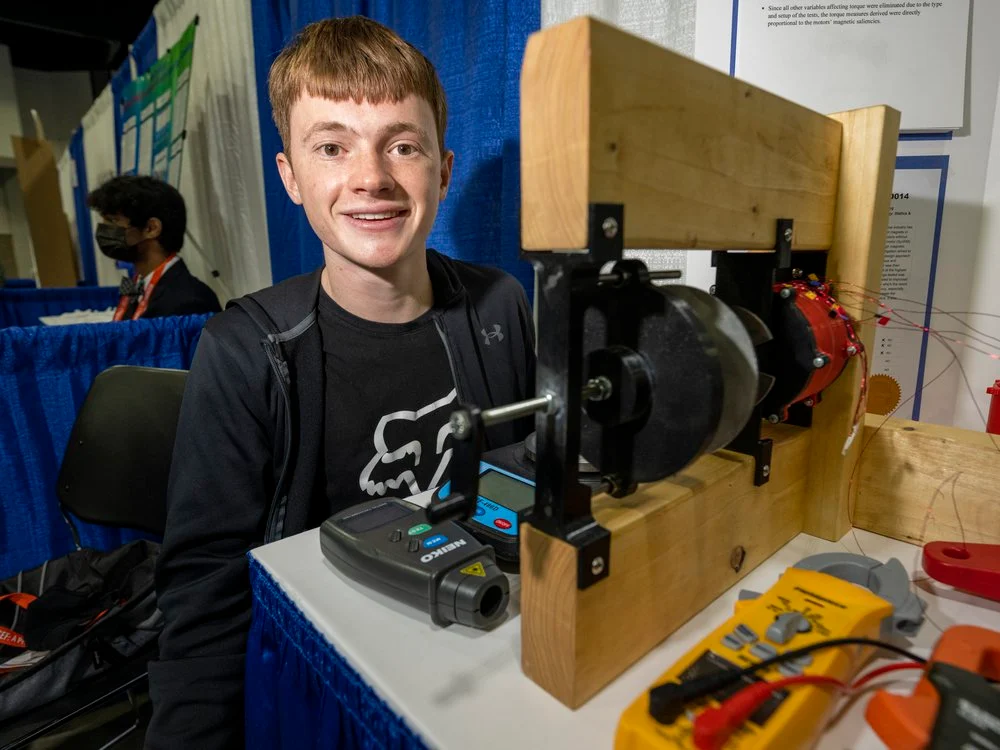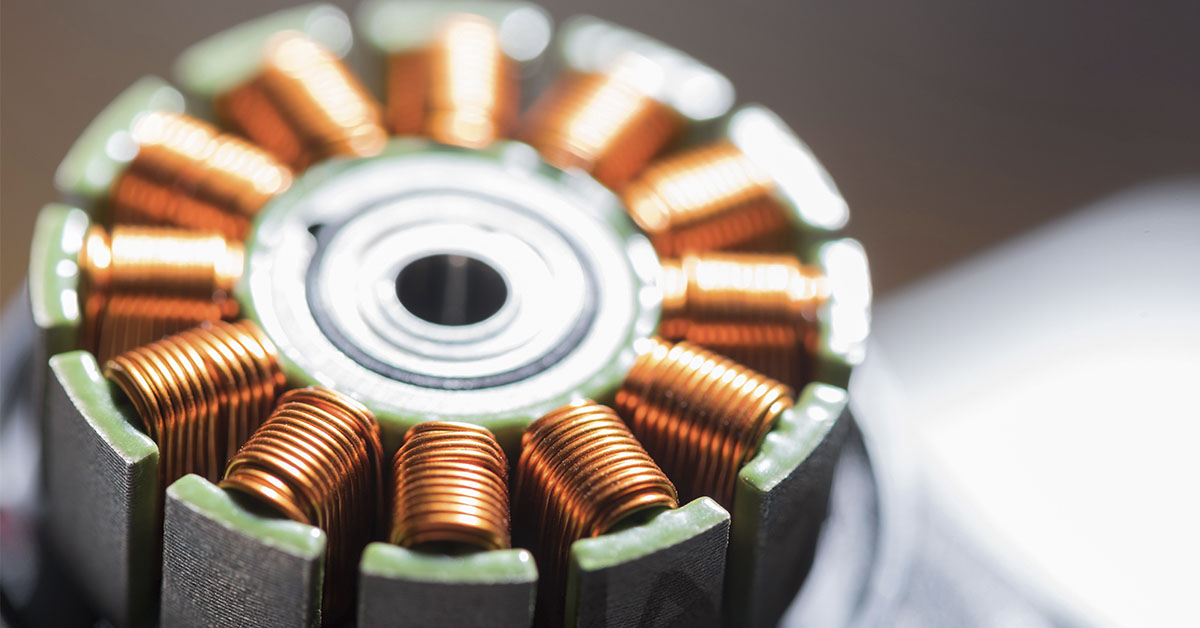Robert Sansone is a prolific engineer, despite his young age of 17 years. The inventor from Port Pierce, Florida, has completed about 60 engineering projects, from high-speed running boots, animatronic hands, and a go-kart that can drive over 70 miles an hour. But a few years ago, he came across a video discussing electric cars, which inspired him to create a better electric motor.
Sansone’s Award-Winning Design
The crucial video explained the disadvantages of most electric cars, namely that they need magnets from rare elements that are difficult and expensive to extract. Not to mention the negative effect of the process on the environment. Therefore, these materials can cost hundreds of dollars per kilogram. But Sansone proposed a cheaper alternative using copper, which is worth $7.83 per kilogram. “I have a natural interest in electric motors,” said Sansone. “With that sustainability issue, I wanted to tackle it, and try and design a different motor.” [1]

He had heard of the synchronous reluctance motor, which doesn’t require these rare materials. It’s often used in fans and pumps, not nearly powerful enough to feature in a vehicle. So Sansone embarked on his mission to make one stronger and more efficient. He made a successful prototype out of a steel rotor, copper wires, and 3D-printed plastic pieces. This project won him first place and a $75,000 award at the 2022 Regeneron International Science and Engineering Fair (ISEF), the largest high school STEM competition in the world. [2]
Read: This electric car built by Dutch students is made entirely of waste — even the chassis
How Do Electric Motors Work?
In order to improve the synchronous reluctance motor, Sansone turned to magnets. Keep in mind, that there are three types of motors at play here. There are the standard electric motors, also known as the induction motor, which use rare and unsustainable materials. They work through a rotor that spins using electromagnetic fields through coils of wire placed on the outer section of the motor. [3]
Meanwhile, synchronous reluctance motors, the kind that inspired Sansone’s experiment, use steel rotors with air gaps cut into them. As the rotor rotates in the magnetic field, it creates torque — a rotational force — as a result of the air gaps. “Magnetic field” in this case refers to the current that creates an electric charge. There are no actual magnets in standard synchronous reluctance motors. Unlike permanent magnet motors.
In permanent magnet motors, magnets line the edges of the rotor to create a magnetic field with the opposite poles, and this magnetic attraction makes the rotor spin. Typically, magnet motors use highly demanded materials like neodymium, samarium, and dysprosium. They are needed in many common appliances, like earbuds.
“The number of applications that use magnets just seems to be getting larger and larger,” said Heath Hofmann, a professor of electrical and computer engineering at the University of Michigan. “A lot of the materials are mined in China, and so the price can often depend upon our trade status with China.” Hofmann is an expert on electric motors and vehicles, even working with Tesla who recently began putting permanent magnets into their induction motors.
Read: Man Harvests Methane for 8 Hours to Fuel Bike That Runs on Swamp Gas
Sansone’s New Electric Motor Design
So when Sansone built his synchronous reluctance motor, he tried using magnets instead of the usual air gaps to create another magnetic field. He theorized this should create more torque. His design includes other unique components but he didn’t reveal more details because he plans to eventually patent his work. “Once I had this initial idea, then I had to do some prototyping to try and see if that design would actually work,” Sansone said. “I don’t have tons of resources for making very advanced motors, and so I had to make a smaller version — a scale model — using a 3-D printer.”
Still, it took several prototypes before he could properly test his theory. “I didn’t have a mentor to help me, really, so each time a motor failed, I had to do tons of research and try and troubleshoot what went wrong,” he said. “But eventually on the 15th motor, I was able to get a working prototype.”
After testing his electric motor, he tested a more typical synchronous reluctance motor to compare. His design had 39% greater torque and 31% greater efficiency at 300 revolutions per minute (RPM). At 750 RPM, it had 37% greater efficiency, but he couldn’t test his design at a higher RPM because the plastic would overheat and melt. He already had a melted prototype to prove that. While the results were promising, they are far from the power required for a vehicle. (To compare, Tesla’s Model S motor — an AC induction motor — can reach 18,000 RPM.) Sansone confirmed these test results in a follow-up experiment, where he “isolated the theoretical principle under which the novel design creates magnetic saliency,” according to his presentation. [4]
Read: Geologists Say a New Ocean is Opening Up in Africa and ‘Splitting it in Two’
A Bright Future
“He’s definitely looking at things the right way,” Hofmann said about the young inventor. “There’s the potential that it could be the next big thing.” But he added many inventors dedicate their lives to research and it’s “fairly rare that they end up taking over the world.”
Plus, Hofmann said that while materials for synchronous reluctance motors are cheap, machines with them are complicated and difficult to manufacture. These high costs can greatly limit the spread of Sansone’s invention. While Sansone acknowledges this, he believes “with new technologies like additive manufacturing [such as 3-D printing], it would be easier to construct it in the future.”
After Sansone graduates from Fort Pierce Central High School, he hopes to attend the Massachusetts Institute of Technology. He’s saving his cash prize from ISEF for college tuition. In the meantime, he is working on version 16 of his electric motor. He plans to use sturdier materials so could test it at higher RPMs. If all goes well, he plans to get a patent for his work and eventually reach out to car companies. He hopes that one day his design will be the prime choice for electric vehicle motors. “Rare-earth materials in existing electric motors are a major factor undermining the sustainability of electric vehicles,” he said. “Seeing the day when EVs are fully sustainable due to the help of my novel motor design would be a dream come true.”
Keep Reading: Irish boy’s innovative idea can remove up to 88 percent of microplastics from water
Sources
- “This 17-Year-Old Designed a Motor That Could Potentially Transform the Electric Car Industry.” Smithsonian Magazine. Margaret Osborne. August 11, 2022
- “Congratulations to the top winners of Regeneron ISEF 2022!” Society for Science.
- “PERMANENT MAGNET VS. INDUCTION MOTOR EFFICIENCY: DESIGN & MATERIALS.” Horizon Technology. Fran Hanejko. January 24, 2022
- “ETSD014 – Investigating a Novel Electric Motor Design.” Regeneron ISEF. Robert Sansone.

